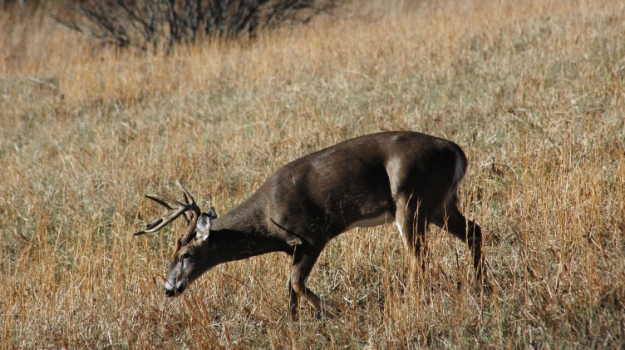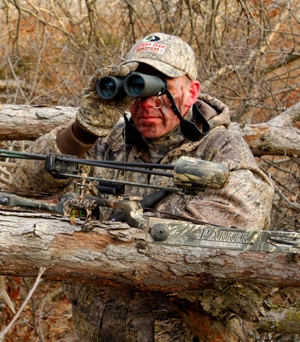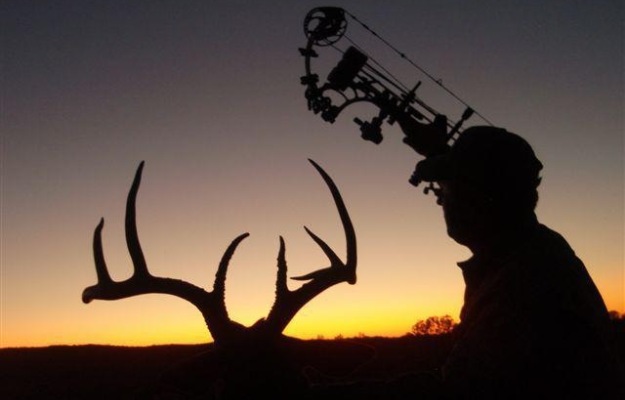
Editor’s Note: This week Justin Eakins, one of Mossy Oak Deer Thugs, tells us how he manages and hunts deer on 30,000 acres at the end of the season on his land at his Canadian River Hilton Hunting Lodge in Crawford, Oklahoma, and how he grows a crop of bucks that he doesn’t plan to harvest for 4 years. Eakins has been a deer hunter for over 30 years.
Gun season starts the Saturday before Thanksgiving and runs for 16 days consecutively. Usually, this includes three weekends. So, our late season hunts are all archery hunts. We've been hunting this same 30,000 acres for 28 years. I know the property and the deer movement patterns almost as well as the deer do. I’ve identified the trails they use to get to the food sources. These are some of the reasons that our bowhunters are so successful in the late season. If a hunter hunts the same property for several years, I really believe that he can understand where bucks will show up at the end of the season every year, because he’ll know where the late season food sources are.
Another thing I do every year at the end of the season is I continue to run my trail cameras and my feeders for several weeks after the season is over. Then I’ll know which bucks have survived hunting season, and which 3-1/2- and 4-1/2-year-old bucks our hunters will have the opportunity to take the next year. Our region has a lot of open country and many draws and creek bottoms where the deer travel. So, we’ll hunt the same areas year-after-year. We can do this, because we keep hunting pressure to a minimum. We depend quite a bit on our trail camera surveys to let us know how many bucks and does we have at the end of the season, how many bucks and does we have at the beginning of the season, and which trails the deer are most likely to use all during the season. When the season ends, I also do a lot of stand maintenance and get ready for the next year.
Another factor that helps us hold deer and pull in older-age-class bucks from other areas is that we keep our feeders running until the end of May. So, when food is scarce in January and February and even into March and April, the deer always know where they can come and get some food to eat. The deer from other properties that are looking for food will come to our land to find food all the way into May. The deer that come from surrounding properties often will set-up residence on our property after the season. Usually, we can hold them until deer season arrives the following fall. Another advantage of running our feeders until May is that the bucks feel comfortable continuing to come to our feeders throughout deer season. We set up our tree stands and ground blinds, so that the bucks should come within 15 or 20 yards of them.
 Up until about 5 or 6 years ago, the Oklahoma deer season closed on December 31. However, since then, we've had the extended archery deer season that goes to January 15. I don’t think the longer season really has had any effect on our deer herd or our hunters. During the extended bow season, I don’t take any more hunters to hunt on our property than I do when gun season closes on December 31. Our hunters don’t have more opportunity to take more deer in the extended season than they have when the season closed on December 31. However, the extended season allows our hunters more time to be more selective and try to take that buck of a lifetime than when the season is shorter. Even if the Oklahoma Department of Wildlife Conservation gave us two more months to hunt deer, I still wouldn’t take any more hunters than we’re currently hunting on our land.
Up until about 5 or 6 years ago, the Oklahoma deer season closed on December 31. However, since then, we've had the extended archery deer season that goes to January 15. I don’t think the longer season really has had any effect on our deer herd or our hunters. During the extended bow season, I don’t take any more hunters to hunt on our property than I do when gun season closes on December 31. Our hunters don’t have more opportunity to take more deer in the extended season than they have when the season closed on December 31. However, the extended season allows our hunters more time to be more selective and try to take that buck of a lifetime than when the season is shorter. Even if the Oklahoma Department of Wildlife Conservation gave us two more months to hunt deer, I still wouldn’t take any more hunters than we’re currently hunting on our land.
If you're not managing your buck population properly, the hunter pressure and the number of hunters you have on the land, then your chances of taking a buck can be decreased in a late season hunt. The real secret to having great late season hunts is: before deer season starts, know how many mature bucks you're planning to try to take off your property. For instance, if we decide we’re going to try to take 30 mature bucks off 30,000 acres, I’ll only book 30 hunters and try to have 100 percent of our hunters taking bucks. Now that doesn’t always happen. But right now, about 85 percent of our hunters take bucks - both bowhunters and gun hunters - and 100 percent of our hunters have opportunities to take bucks. What’s even better is every time a hunter gets on a stand, he’ll average seeing three to six bucks. Now, not all those bucks will be shooter bucks, but he’ll see plenty of bucks.
Here’s another thing we do. We don’t believe in hunting hard. We believe in hunting smart. We scout hard and put in a lot of hours scouting. Then we hunt smart by putting our hunters in the places where they're most likely to see and take mature bucks. Hunting smart also means that if we know where there’s a really nice trophy buck, and we feel certain our hunter can take him, but the wind direction is wrong to hunt that site, we won’t hunt that spot with a bad wind. Also, we hunt defensively. We try not to spook the bucks we want to take. If we hunt a mature buck with a bad wind, we know that our hunter won’t get a shot at the buck that day. More than likely, the next three hunters who hunt from that same stand won’t have an opportunity to take a mature buck. We only hunt the best stands where we have the best chances for success. This process is what I mean by scouting hard and hunting smart.
To contact Justin Eakins, call his cell phone at 580-497-7500, and leave a message. His home phone is 580-983-2500, the website is www.canadianriverhilton.com, or you can email him at hunt@dobsonteleco.com.
Tomorrow: DEER THUG Justin Eakins on How We Manage Our Deer Herd to Produce Great Hunter Success



























